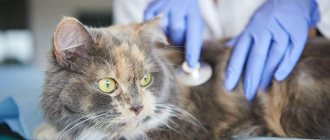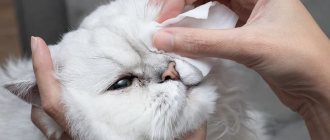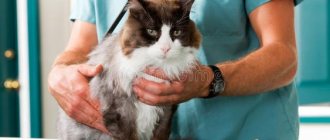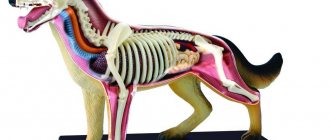Good afternoon, our dear readers! We, the Valitov brothers, are always happy to welcome you to the pages of our blog to discuss various situations together.
Today we’ll talk about a disease that tends to bring pain and suffering to our smaller brothers - it’s weeping eczema in cats.
This inflammatory pathology of the surface layer of the skin in cats often manifests itself as an acute form of the disease, accompanied by itching and weeping discharge.
The disease is considered difficult to cure. It is most difficult for long-haired breeds of animals aged from one to two years.
What types of weeping eczema develop in cats, what are their symptoms, causes of appearance and stages of development? How the owner should treat his tailed pet, for which he is responsible, we’ll talk about this a little later.
Stay with us! Read, you will learn a lot of interesting things!
How does the disease manifest itself?
Because of the fur of cats, the owner cannot always detect the symptoms of eczematous pathology in his pet. However, the unbearable itching of the animal can alert him.
When examining the animal, you can notice inflamed, reddened skin at the site of scratching. Here she is tight and hot.
The situation is aggravated by the constant trauma of the claws to the inflamed area, the penetration of pathogenic bacteria into the scratches, the formation of small nodules and watery blistering rashes there.
Next, these bubbles open, pyogenic contents infected with bacteria are released from them, which gives rise to weeping areas, erosion, ulcers, and rotting of the epidermis.
The main location of this disease in cats is observed in the area:
- Back to end of tail;
- Ear areas.
Treatment of the inflammatory process
Treatment of inflamed paraanal glands should only occur in a veterinary clinic under the supervision of a physician after a thorough examination and assessment of the severity of the lesion.
Therapy involves cleaning, rinsing or removing the affected glands.
Cleaning
At the initial stage of the disease, cats undergo cleaning of the paraanal glands. Depending on the consistency of the accumulated secretion, this procedure can be carried out in the clinic or at home by a visiting veterinarian or an experienced breeder. In any case, cleaning brings discomfort to cats, so it will be more convenient to do it together.
Before cleaning the glands from accumulated secretions, it is necessary to palpate them to determine the consistency of the contents.
If the secretion is liquid, you can clean it yourself using an external method. The animal should be secured, the inflamed glands should be covered with a napkin and their contents should be carefully squeezed out - to do this, you need to squeeze the sides of the anus with two fingers and squeeze.
If a liquid with a very pungent and unpleasant odor appears, the procedure can be considered successful. At the end of the manipulation, the anal area must be treated with Chlorhexidine.
If the contents of the glands are dense, the procedure should only be performed by a doctor, since the cat will need internal cleaning, which is called the rectal debridement method. In such a situation, the index finger is inserted into the animal’s rectum, the outside is felt with the thumb and the contents are gently squeezed out. At the end of the procedure, the anus is treated with an antiseptic solution, and ¼ of an anti-inflammatory suppository is inserted inside.
Important! It is forbidden to clean cats that do not have inflammation of the paraanal glands, since such intervention can lead to disruption of their normal functioning.
Washing
Washing should be carried out exclusively by a veterinarian in a clinic setting. This procedure is indicated in the most severe cases, when a fistula or abscess has formed, and other methods do not bring results.
First, the cat's anal glands are cleaned mechanically. Then, under local anesthesia, a solution of potassium permanganate, Chlorhexidine or another antiseptic is injected into the anus using a catheter or syringe without a needle.
The procedure must be repeated several times until the flowing liquid becomes clear. This will indicate that there is no thick secretion or pus left in the paraanal glands. Next, the cat is given rectal anti-inflammatory suppositories, and the outside of the anus is lubricated with antiseptic ointment.
Important! Depending on the severity of the disease, the animal may also be prescribed antibiotic therapy.
Removal
In the most severe cases, when it is no longer possible to clean and washing does not bring results, veterinarians remove the paraanal glands from cats. Doctors also recommend this operation for pets who constantly suffer from blocked ducts.
Regular cleaning is a significant stress for cats, so removing the anal glands will make life easier for both owners and their pets.
The removal operation is performed under general anesthesia. The doctor makes 2 small incisions in the area where the anal glands are located, removes them along with the ducts and applies sutures. In the future, the owners need to treat the wound with a healing preparation, and also give the cat vitamins for speedy skin regeneration and antibiotics (if indicated, for 5–7 days).
Important! Owners need to ensure that the cat does not become constipated until the stitches heal. Otherwise, they may separate.
Causes of the disease
External and internal factors are involved in the development of disease symptoms in cats.
External factors often include:
- Wool dirt;
- Constant friction;
- The influence of parasites;
- Using soap when bathing an animal;
- High or low temperatures;
- Microbial infection.
Internal factors that can cause weeping eczema in cats include:
- Weak immunity;
- Endocrine pathology;
- Ovarian dysfunction;
- Diseases of internal organs.
Diagnostics
If a cat has light, cloudy or bloody discharge from the anus, the anus itself is swollen and hurts when pressed, it is necessary to urgently take the animal to a veterinary clinic. An experienced veterinarian will be able to establish an accurate diagnosis during the initial examination. However, with other diseases, you may notice that ichor or blood is dripping from the anus. Therefore, additional diagnostic methods are necessarily prescribed:
- general blood and urine analysis;
- biochemistry;
- microscopic examination of feces;
- radiography;
- Ultrasound of organs located in the abdominal cavity.
Return to contents
Types of disease
Depending on the reasons causing the development of the disease, veterinarians distinguish several types of weeping eczema in cats.
Traumatic
This type of eczematous skin lesions in cats is directly related to traumatic or irritating factors, and these are:
- Collars;
- Harnesses;
- Bites from fleas, ticks or other insects;
- Deep scratching;
- Burns or frostbite.
Neuropathic
This disease is associated with the manifestation of autonomic disorders in cats. It can be:
- Panleukopenia;
- Stress;
- Nervous disorders.
In this case, the symptoms of eczematous manifestations of this type of disease are accompanied by itching, increased hair loss in the animal, and symmetrically located affected areas.
Reflex
This type of eczematous pathology in cats is accompanied by severe itching, which is a consequence of:
- Hypersensitivity to detergents, kerosene or alkalis;
- Heavy contamination of the animal;
- Kidney or liver diseases;
- Overweight;
- Deficiency of animal protein or vitamins in the body;
- Hormonal imbalance;
- Insect or parasite bites.
Clinical picture
This disease is characterized by a relapsing course with exacerbations that occur more often in the warm season (more microorganisms). The main signs are: severe itching, which is why a sick cat can scratch the skin vigorously, sometimes until it bleeds; rashes on the affected skin, peeling, flaking; dry skin all over the body. Blisters and papules gradually form on the skin. They open, resulting in a large amount of ichor flowing onto the skin. Being contaminated with pathogenic and conditionally pathogenic microflora, the exudate begins to decompose and smell bad. All this not only causes your pet severe pain, but can also cause the development of septic phenomena.
Unconventional approaches
Today, veterinarians have the opportunity to expand medical care for animals using unconventional approaches. Some advice in this regard can be found in Peter Urton's book Eczema Freedom in Three Easy Steps.
The innovative techniques and recipes presented in this unique manual really work against weeping eczema. At the same time, they are simple, accessible, and help to rid the animal of illness in a short time.
If you want to learn more about weeping eczema in cats, we advise you to become a subscriber to our blog in order to receive new interesting information in a timely manner. In addition, in your comments you can share with us your thoughts on this issue.
Goodbye, see you again!
Discharge in cats from the loop (vagina)
In females, fluid under the tail can flow not only from the glands or anus, but also from the genitals. In some cases, mucus in the cat's loop area is a natural sign of estrus, and fluid may also be released from the uterus after birth. However, often bloody or purulent masses flowing from the loop indicate the development of a serious pathology of the reproductive system.
Physiologically determined secretion
Vaginal secretion is considered normal if it appears in a cat during estrus, immediately before the onset of labor, or after the kittens are born. When in heat, they have a slimy consistency. The discharge from the loop is transparent and homogeneous, but the presence of small spots of blood in it is also considered normal. The physiological liquid substance during estrus has no odor, so in most cases it goes unnoticed by the owners and ceases to be released after a few days.
Before giving birth, a white or yellow mass comes out of the vagina. There may also be a small amount of blood present. After the start of contractions, the cat's amniotic fluid is greenish in color. After childbirth, it is important to observe the color of the mucous secretion coming out of the genital tract. If it has a bloody tint, then it is necessary to show your pet to a veterinarian to prevent the development of complications.
Purulent discharge and its cause
When a cloudy mass comes out of a pet’s loop, this always indicates the development of pathology. Purulent clots are released from the vagina with the following disorders:
- injuries of the genital organs, ureter;
- pyometra;
- infectious lesions of the reproductive system;
- urological diseases.
Bloody issues
Brown or reddish vaginal discharge from a cat that is not pregnant, is not about to give birth, and is not looking for a mating partner is also not normal. This phenomenon indicates an inflammatory process in the internal genital organs and other pathologies. The cat must be taken to a veterinary clinic for examination. The sooner the cause of the disorder is identified, the greater the animal’s chances for a quick recovery.
Bloody discharge often appears in diseases caused by hormonal imbalance, coagulation disorders, endometritis, and inflammation in the uterine cavity. In addition, brown and red mucous clots are observed in cats with neoplasms in the vagina, vaginitis. Since cats are very clean, owners may not notice the discharge until the disease reaches a severe stage, so it is important to carefully monitor their pets and pay attention to changes in their behavior, mood, appetite, and habits.
Prevention, advice to owners
In the treatment and prevention of “wet tail”, it is important to follow the rules of hygiene - clean the cage in a timely manner, replace food and water daily, wash your hands after interacting with animals (since the infection is easily transmitted from one rodent to another).
If several animals are kept in one cage, then the sick should be immediately isolated and the cage should be thoroughly cleaned.
Further care should begin with healthy pets, and then only carry out hygiene procedures on sick animals.
It is not advisable to keep a sick pet in the same room as healthy ones.
Several times a day, the cage of a sick rodent is disinfected with antiseptics and the bedding is changed - these actions help to avoid re-infection.
Symptoms of anal gland blockage
In the initial stage, the cat begins to frequently lick under its tail, becomes restless, rides on its butt on carpets and other rough surfaces, and an unpleasant odor appears from the animal.
As the condition worsens, inflammation of the glands develops, which manifests itself:
- Enlarged sinuses and their pain.
- Decreased appetite.
- Lethargy of the animal.
- The development of purulent abscesses with increased body temperature and general intoxication.
What diseases have a similar clinical picture?
The symptom of licking the anus and riding the butt is also characteristic of:
- Worm infestation.
- Allergic reaction.
- Psycho-neurological disorders of the animal.
- Stress.
Is this anal fluid?
If you see your cat losing fluid from the anal area, it is likely due to one of the above reasons. However, you must be very careful to correctly identify the source. In the case of women, we must ensure that the secretion comes from the anus and not from the vulva. If there is discharge that is pink, bloody, or contains pus, then it may be a reproductive problem. If your cat has not been spayed, she may be pregnant. However, such discharge can also be a sign of infection of the uterus or piometra . In any case, you should seek veterinary help immediately to determine the problem and find a course of treatment...
This article is purely informational. HowMeow.ru does not have the right to prescribe veterinary treatment or diagnose. We invite you to take your pet to the vet if you are suffering from any illness or pain.
ZooForum: Wet under the rabbit’s tail – ZooForum
(others can give advice in a PM, indicating that the advice is not given by a veterinarian. But the forum is not responsible for THESE advice.)
Wet under the tail of the rabbit does not have diarrhea
Decorative lion-headed rabbit. Age - 3 weeks. The rabbit is already litter trained and does all his business there. But for some reason the fur near the tail is constantly wet. We tried washing it twice - it lasted for half a day, then it was wet again. And it's not diarrhea. Tell me, what's wrong with him?
This is urine. We poop normally - like peas. We went to the vet - we were told that it was most likely because he was taken away from his mother as a small child (at 3 weeks). They prescribed chamomile, gamavit, urological preparation and ampicillin. I'm afraid to give him ampicillin - they write everywhere that you can't give it to rabbits.
Good evening, Mikhail. Today we received the results of urine tests - not at all reassuring. I'm afraid to convey something incorrectly, so I'll give a photo of what the doctor wrote:
I forgot to say that the rabbit has not peed at all for two days. I have to squeeze urine out of him in the morning and evening. the penis is inflamed and swollen. This is what it looks like now:
Basically. It's not fatal, although it's strange. that cystitis developed at such an early age - you need to take an x-ray (perhaps the squeak is blocked in the urethra and therefore he cannot urinate) - if papaverine does not help, I would switch to no-shpa with analgin and still start antimicrobial treatment (biseptol).
Thanks for the quick response! It turned out that the whole issue was not in the kidneys. The rabbit has some kind of anomaly - either congenital or injured. The place where he should write from is overgrown. There is a fistula due to inflammation, either they will operate or. Tomorrow the doctors will decide what to do.
This means we are not the first... Mikhail, please tell me - can this be corrected? Or how to put it correctly - I don’t know. In general, the operation
Source
What to do at home
Self-medication is dangerous to health! Using medications, especially human medications, without consulting a specialist can worsen the situation!
You need to understand that involuntary urine leakage is not mischief or stubbornness at all, it is a disease from which the pet suffers. Follow all the veterinarian's instructions and provide your pet with good care and adequate feeding.
And, of course, surround your four-legged pet with love and care so that he feels safe.










